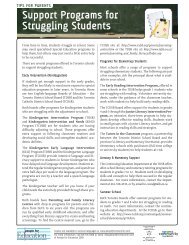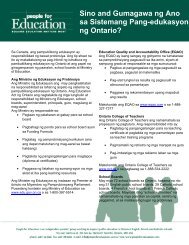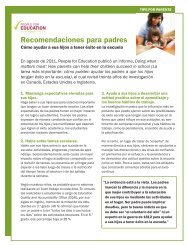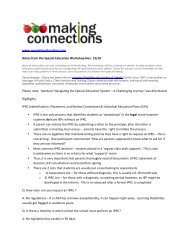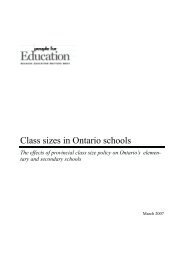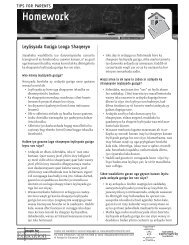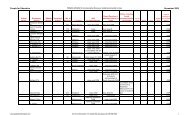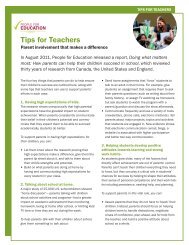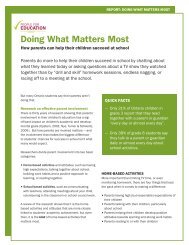Our Children Our Future Our Vision - People for Education
Our Children Our Future Our Vision - People for Education
Our Children Our Future Our Vision - People for Education
You also want an ePaper? Increase the reach of your titles
YUMPU automatically turns print PDFs into web optimized ePapers that Google loves.
<strong>Our</strong> <strong>Children</strong>, <strong>Our</strong> <strong>Future</strong>, <strong>Our</strong> <strong>Vision</strong><br />
Auditor General to per<strong>for</strong>m a review comparing the funds it allocates to schools operated by First<br />
Nations with the funds those schools would receive under the applicable provincial funding <strong>for</strong>mulas.<br />
INAC concluded that per-student funding was similar, with the exception of some regional<br />
differences. 159<br />
However, a detailed gap analysis conducted by the Union of Ontario Indians in 2009 indicated that<br />
the funding provided to 22 First Nations Band-operated schools yields a shortfall <strong>for</strong> First Nations<br />
of almost $16 million. 160 The BOFF is a stagnant <strong>for</strong>mula that has not been updated since 1996,<br />
whereas the provincial <strong>for</strong>mula is much more dynamic and flexible to meet the ever-changing<br />
needs of students. 161<br />
INAC attempted to supplement the BOFF by introducing supplementary proposal-based programs.<br />
These programs are not based on cost and do not provide stability, permanence, or parity in funding<br />
resource levels. Today approximately one third of elementary and secondary funding <strong>for</strong> First<br />
Nation schools is provided in this manner. The introduction of additional proposal-based programs<br />
adds a substantial reporting burden to already under-funded First Nations who often lack the capacity<br />
to apply <strong>for</strong> the additional funding. Proposal based funding also adds a significant element<br />
of competition among First Nations communities and organizations. Proposal-based programs<br />
include:<br />
• New Paths <strong>for</strong> <strong>Education</strong> Program<br />
• Improving School Effectiveness<br />
• Teacher Recruitment and Retention<br />
• Parental and Community Engagement Strategy<br />
• First Nation Student Success Program<br />
• Cultural <strong>Education</strong> Centres Program<br />
• <strong>Education</strong> Partnerships Program<br />
These programs were introduced upon the recognition that First Nations were lacking the second<br />
and third level supports of an education system and represent a “problem-centred” approach. 162<br />
159 OAG Status Report, 2011, supra note 134 at 4.19.<br />
160 S. Cantin, “F.N. Band Operating on-Reserve Schools: Comparison Between the 2009-10 Financial Agreement with<br />
INAC and the Provincial Funding Regulation <strong>for</strong> School Authorities using 2009 Nominal Roll Enrolment” (2009). This<br />
was an internal study completed <strong>for</strong> the Union of Ontario Indians and not available publically.<br />
161 P, Garrow, “An Assessment of the Ontario Band Operating Funding Formula Comparative Study” (2005) at 14. This is<br />
an internal document not available publicly.<br />
162 D. Anderson, “Report on Second Level Services <strong>for</strong> First Nations <strong>Education</strong> Current and <strong>Future</strong> Needs” in Manifesto,<br />
supra note 11 at Tab 12, page 4.<br />
Chiefs of Ontario<br />
36




